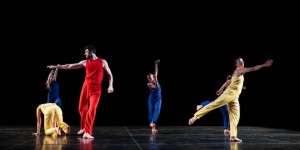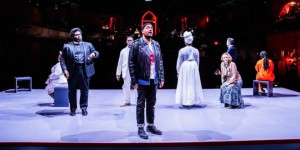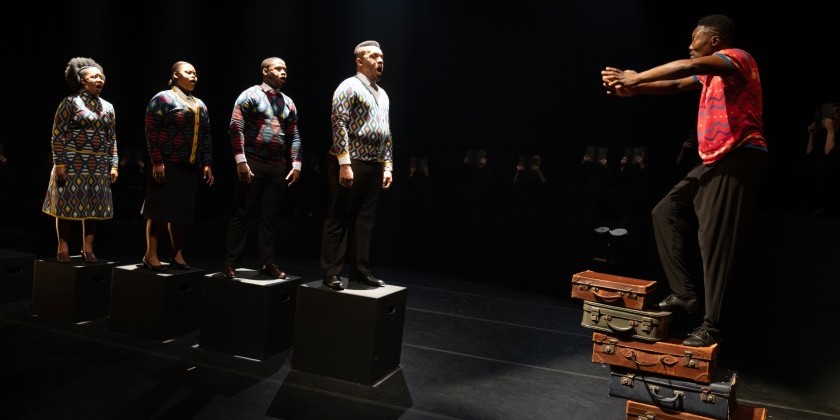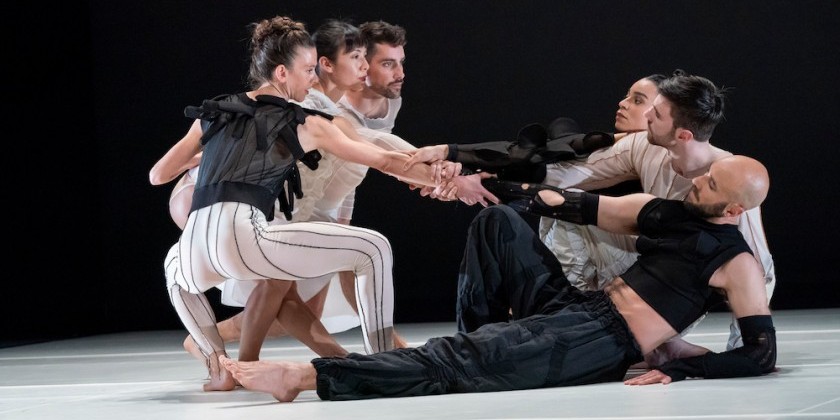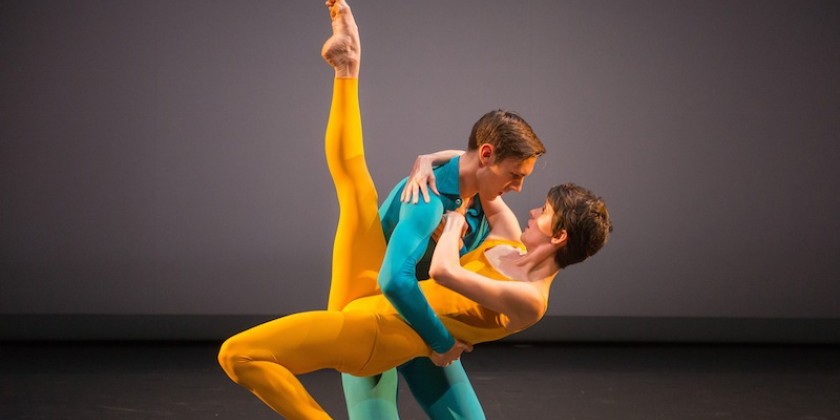Impressions of The Trisha Brown Dance Company
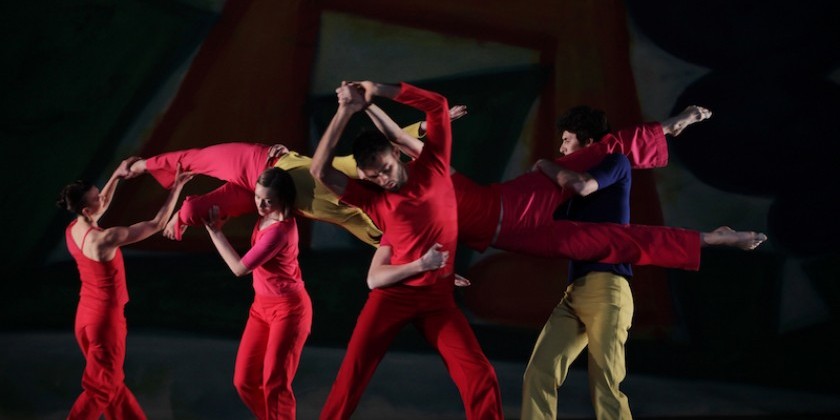
At the Brooklyn Academy of Music
Howard Gilman Opera House, 30 Lafayette Avenue, Brooklyn, NY
Friday, 29 January 2016 @ 7:30 p.m.
Dancers: Cecily Campbell, Marc Crousillat, Olsi Gjeci, Leah Ives, Tara Lorenzen, Jamie Scott, Stuart Shugg
Choreography: Trisha Brown
Musical Scores: Laurie Anderson, original music “Long Time No See” (for Set and Reset); John Cage, "Sonatas and Interludes” (Present Tense); Peter Zummo with Donald Judd, original sound orchestration and production, and Donald Judd, sound concept (Newark [Niweweorce])
Visual Presentation: Robert Rauschenberg, including costumes (Set and Reset); Elizabeth Murray (Present Tense), costume design reimagined by Elizabeth Cannon); Donald Judd (Newark [Niweweorce])
Lighting Designs: Beverly Emmons with Robert Rauschenberg (Set and Reset); Jennifer Tipton (Present Tense); Ken Tabachnick (Newark [Niweweorce])
Trisha Brown, stricken with an illness that can't be evaded, is permanently retired from the stage and from choreography. Her works for proscenium theaters are also about to be retired by her company, which will continue as a project-based organization rather than one that tours established repertory. The valedictory New York City program of three Brown dances, performed in late January at the Brooklyn Academy of Music, represented much more than themselves: they stood for over 100 dance works in a more than half-century-long theatrical career by a brainy — and unemphatically witty — iconoclast, whose performing environments of choice ranged from opera houses, such as this one, to the surfaces of buildings, and whose achievements ranged from the choreography and direction of operas and classic song cycles to such postmodern experiments as a dance for urban living in the form of gestures relayed among performers positioned on Lower Manhattan rooftops. Although Brown grew up on the West Coast and was educated there, as with her Washington State landsman Merce Cunningham, her imagination, so sensitive to space and weather, seemed to thrive especially in the architectural density of New York.
When I first saw Brown and her dance group entirely made up of wonderfully individual women, in the early 1970s, she was emphasizing impersonal charm and intellectual surprises through dance movement of rhythmic exactitude, muscular relaxation, and mathematical processes of choreographic composition. She called these “line-ups” and “accumulations.” In her 1973 Spanish Dance, the five performers wore thin, off-white, longsleeved tops and wide-legged capris. When they inched with a sinuous walk on precise counts into a conga line, to the Bob Dylan recording of “Early Morning Rain,” their insinuating arms uncoiled overhead in a separate rhythm from that of their steppings. By the end of the song, the conga line had literally walked itself into one of the white walls of the Portland Center for the Visual Arts. Through the audience ran a tremor of delight at the cognitive dissonance between the unbearable gravity of the Gordon Lightfoot lyrics and the unbearable lightness of being embodied by the dancers. Spanish Dance must be one of the simplest dance constructions that Trisha Brown ever put together, but its effect of making anyone who watched it glad to be alive was huge and memorable.
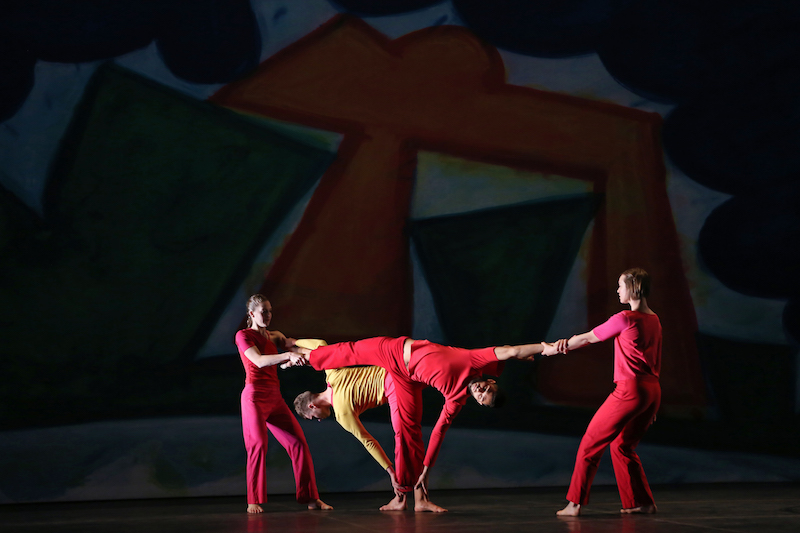
As an observer of Brown and her company over the decades, I've had the privilege of seeing her several generations of devoted executants. However, apart from the irreplaceable, charismatically focused movement of the young Stephen Petronio in the first, 1983 season of Set and Reset, not even the historic original casts of the three works presented at BAM could be said to surpass the dancers of the Trisha Brown Dance Company in 2016 for sheer dance power. Associate artistic co-directors Carolyn Lucas and Diane Madden have discovered, coached, and maintained what is, in performance, an artisanal instrument whose working parts happen to comprise human beings. Again, as with Cunningham's final, sleekly accomplished company of dancers, the fact that the repertory goes out of existence on a high of such strong performances is both a tragedy of life and a tribute of art. To see incisive, centered, wide-eyed and wiry Jamie Scott, a remarkable member of both companies, once again ushering a repertory of genius into the beyond was almost more than a veteran dancegoer could bear.
The choice of these three dances for a last program was perhaps a no-brainer, since all were either audience favorites or the subject of enduring critical fascination and all had sets that would be able to tour without major upheaval. However, their order made one ponder the nature of Brown's art and legacy — her moxie as well as her affable charm and her blending of postmodern explorations in painting and sculpture with her expansion of movement vocabulary and her redrawing of convention in postmodern dance. Set and Reset — whose dancers' weights seem to add up to only a few ounces — starts with a woman lightly and suddenly assisted by a couple of her colleagues to “walk on a wall” in a horizontal position (a theatrical reminder of Brown's most famous outdoor work, in which she and several other individuals literally walked down a building's brick wall with the assistance of pulleys).

The black-and-white Rauschenberg designs — projections of newsreel films on geometric elements and silkscreens of photographs on gossamer versions of the outfits in Spanish Dance; the apparently casual and purely spontaneous movement phrases from which dancers leap like so many flying fish, without visible preparation; the liquefaction of the flowing choreographic paths, now and then coagulating by the winglines, all married to Laurie Anderson's breathy insinuations make Set and Reset Brown's perfect program opener, pulling in an audience before it knows what it's doing. Present Tense (2003) — with an ingratiating, full-color, childlike, figurative design elements by Elizabeth Murray, a close friend of Brown's and, like Brown, an alumna (though younger) of Mills College, in Oakland — has, as a score, John Cage's early (1946-48) “Sonatas and Interludes,” nearly two dozen short pieces for prepared piano, that has been manipulated to give it the sound of a gamelan, or something like a gamelan. Brown, in response, adds a touch of Asia to her movement, with stillnesses and bent-kneed poses that give the work a meditative, even a tender quality. It is a very different world from that of Set and Reset, but still outgoing toward an audience.
Chronologically, Newark [Niweweorce] (1987) should have been placed second, but, had it been put there, the company risked losing part of its audience. Also, to have it last leaves an impression of an artist for whom there are no aesthetic cadences, only guillotine cut-offs. It leaves a last impression of life passionately lived to the final instant. I well remember the New York première of Newark, and the audience protests at its sound score, an intermittent series of sustained tones that made some audience members feel as if they would go mad to be in the presence of those sounds. Then, as if in some sort of postmodern-artistic torture chamber, the sounds would cut off and, in silence, the drops of intensely saturated solid colors — eggplant, mustard, etc. — would lower at various planes, cutting off more or less of the stage space, as the cast of six planted themselves into the most architectural ensembles I, for one, know of in Brown's work, with, central to them, an ongoing, hard-bodied duet for the two men of the cast (Olsi Gjeci and Stuart Shugg). Compared to Brown's earlier dances, the look of all the dancers' bodies in Newark was dramatically different from that in Set and Reset: it was a look of enduring stone. (The male musculature emphasized that effect in the duets.) Newark is not an ingratiating or sinuous or pretty dance in any way, and the alienating, Brechtian result of those awful tones completes the refusal to make a work of art that is anything more than the embodiment of ideas. Wow. By 2016, no one (at least, no one I saw at BAM) left; the only people standing were those in a tumultuous concluding ovation. The sounds were no less appalling than the music in the audience's earphones on the subway or the street sounds of workaday New York.
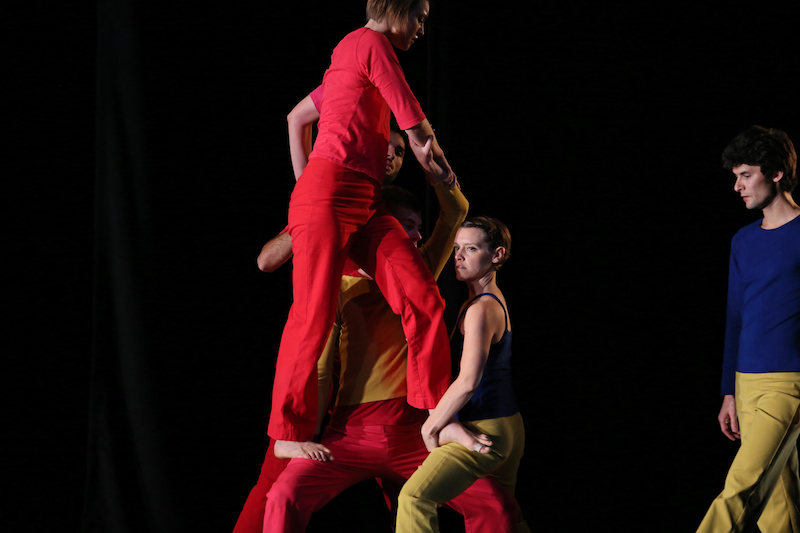
In 1987, Jack Anderson published an arresting story about Trisha Brown's City Center season, in which Newark (or Niweweorce) was programmed for the first time in New York. There, he explains its mysterious title:
“She cautioned during a recent interview [that] no one should expect Newark to reveal anything about New Jersey. A section of the dance, which received its world premiere this summer in Angers, France, had been performed by Ms. Brown's company last season on tour. This excerpt was listed on programs and referred to in Ms. Brown's conversations simply as 'New Work.' But she found herself saying 'New Work' so often that she blurred the words together, making them 'Newark.' Then, she said, 'I realized I had a title sitting right there.'
“Because she relished the sheer sound of 'Newark,' she did a little research and discovered that 'there has always been a Newark.' Long before the New Jersey city was founded, a British town called Newark existed in Nottinghamshire, and she learned that the town's Anglo-Saxon name was 'Niweweorce.' Ms. Brown liked that name and considered using it as her dance's title. But she decided regretfully that it would be too hard to spell and pronounce.
The choreographic 'Newark' is an energy study which, said Ms. Brown, 'is anchored visually and rhythmically in a duet for two men around which dancing of other temperaments occurs.'
Later, there is a second male duet. But Ms. Brown originally choreographed it for two women; it is a practice that reflects her interest in exploring and, if she wishes, ignoring dance's conventions of gender and partnering.”
I would like to correct one point that is minor, as it was in parentheses. The beginning of Set and Reset refers to Trisha's Walking on the Wall, an indoor piece that premiered at the Whitney in 1971. Several people walked on the gallery walls, giving the audience a very similar view to the one she reprised in Set and Reset. The outdoor piece Man Walking Down the Side of a Building was done the previous year, and the performer was a single man. The view of the audience was mostly from below, looking up at the man. That piece has been reprised only in outdoor settings and only with a single performer. Also, its arguable that her most famous outdoor work is Roof Piece (1971). Certainly, Babette Mangolte's photo of it has become iconic on an international scale.
Share Your Audience Review. Your Words Are Valuable to Dance.
Are you going to see this show, or have you seen it? Share "your" review here on The Dance Enthusiast. Your words are valuable. They help artists, educate audiences, and support the dance field in general. There is no need to be a professional critic. Just click through to our Audience Review Section and you will have the option to write free-form, or answer our helpful Enthusiast Review Questionnaire, or if you feel creative, even write a haiku review. So join the conversation.




